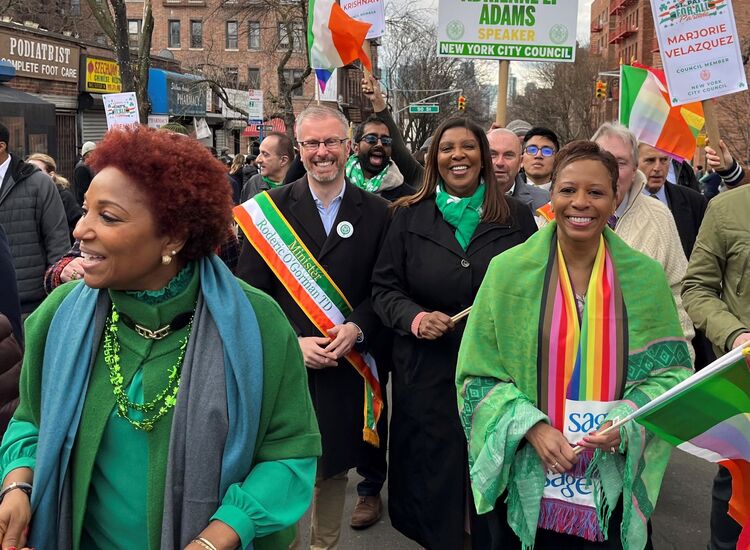County Roscommon fiddle player Mossie Martin gets some help from his dad and his siblings for his album “Humours of Derrynacoosan.”
By Daniel Neely
There’s nothing quite like trad for trad’s sake. In the ol’ media player this week is Mossie Martin’s “Humours of Derrynacoosan,” an album that provides listeners a fine expression of what great traditional music is all about. Martin, a fiddle player from County Roscommon, has done something really sweet and lovely with this one, taking a set of older local influences and finding ways they articulate with his own musical experience. The result is a fabulous album of engrossing fiddle music that will appeal greatly to fans of traditional music.
Martin comes from a musical family (see below) but also had the benefit of being raised within a Connacht community rich with musicians who gave him insight into the older styles of playing. Now a music teacher with his own accredited practice, Martin is a regular tutor at the Joe Mooney and O’Carolan summer schools and a member of the Dartry Céilí Band. Historical influences on his playing include musicians from North Connacht like Michael Coleman, James Morrison, Paddy Killoran, Turlough Carolan, Seamus Tansey, Matt Molloy and others, but he counts folks like Frankie Gavin, John Carty, Kevin Burke and other contemporary players as important influences as well. You can really hear all of them Martin’s overall feel, but at the end of the day it’s his own great tone and the very relaxed sense of rhythm and phrasing he brings to the music that lifts the tunes and endows them with a spirit befitting his North Connacht heritage.
https://youtu.be/G_6CDrjeYho
Martin is, of course, the featured player here, but his supporting cast – a family affair – adds substantially to the music’s enjoyment. His father Tom Martin joins him on mouth organ for a couple of tracks, his sister Áine joins him on harp for four tracks, and his brother Brendan plays fiddle on three tracks and banjo on one. It is very evident to hear the connection in their music, especially through the similarities in their phrasing and approach. The album also includes an important musical contribution its producer John Blake, alternating on guitar and piano throughout. Blake very clearly has an intuitive sense of the Martin family’s music and excels in his roles here.
The album opens with a pair of jigs, both of which Martin composed, that set a strong tone. Accompanied by his brother Brendan, “Susan Sweeney / The Humours of Derrynacoosan” are great, memorable tunes, delivered with a strong drive and great intensity that I think folks will enjoy. Martin’s compositional skills are also shown off later on the great “Himalayan Hornpipe,” which has some sneaky, twisty elements to it that are a delight to hear. While there are some great, more familiar older tunes, the fiddle player also pays tribute to his friends, notably Shane Meehan, who with Martin participated in the 2009 “Leitrim Equation” project with Lúnasa. Meehan’s reel “The Visit To Crouch End” is paired with the commonly “Sailor on the Rock” and “Tear the Calico” to great effect. I also love “The Aghacashel Reel / Laura’s Reel,” by Josephine Keegan and Philip Duffy (leader of the Darty band) respectively. He plays these in duet with his sister, showing lovely swing and a nice warmth of expression. His take on Néillidh Boyle’s “The Moving Clouds” is fascinating as well.
https://youtu.be/dyokLJhUQ28
The two tracks on which Tom Martin appears stand out to me. “Cathleen Hehir’s / Going to the Well for Water,” a pair of slides on which Mossie and Tom feature without accompaniment, and “The Teetotaller / St. Anne’s,” a pair of reels that includes Tom and all three Martin kids (w/Brendan on banjo), have a homely, welcoming vibe to them. The tunes are very well known, the timing’s sweet, and the playing’s easy – lovely stuff.
The album also includes a couple of tracks that contrast the dance tunes well. Martin plays “Planxty MacClancy,” a composition of harpist Michael Rooney written around the story of Spanish Armada Captain Francisco de Cuéllar who found shelter in Leitrim after a shipwreck in 1588. Performed with harp accompaniment, it is a stunning piece with a beautiful arrangement. Martin also includes Carolan’s “Mr. O’Connor.” Here, he plays whistle and is accompanied on the harp, a combination that teases out the piece’s baroque charm.
“Humours of Derrynacoosan” is a finely selected and delivered album that reveals Martin as a superb young player with the deepest respect for tradition. His approach here reminds me of albums from similarly strong young fiddlers, like Dylan Foley’s “Deliriously Happy,” Shane Meehan’s “’twill Do,” Declan Folan’s “All in Good Time,” and Aidan Connolly “Be Off,” all of which are excellent. Fiddle fans will enjoy this album greatly, as will anyone who loves traditional music played with great affection for the past. Recommended! For more information, visit www.mossiemartin.com.








